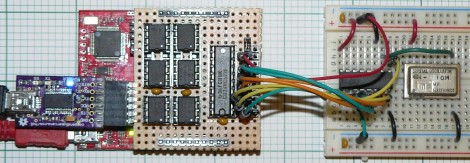
Here’s a 6-channel logic analyzer shield for the MSP430 Launchpad. It manages an eyebrow-raising 16 million samples per second. The prototype seen above is made on a hunk of protoboard with point-to-point soldering. [oPossum] did lay out a PCB — which is just 50mmx50mm — but has not had any produced quite yet.
He calls it the LogicBoost, and based it on the the LogicShrimp design. The sextuplet of 8-pin chips are all SPI RAM. These are responsible for storing the samples, with a 74HC573 latch routing the traffic. The MSP430 chip provides the SPI clock, and the Launchpad’s virtual com port can be used to push the data to a computer for graphing. That’s a bit slow so [oPossum] also included an optional header for an FTDI board that will do a faster job. The sample rate can be adjusted by tweaking the internal oscillator setting of the chip; there’s plenty to choose from so it will work for just about any purpose (as long as you don’t surpass the 16 Msps speed limit).
[via Dangerous Prototypes]
















Cool, but it doesn’t beat mine for cost/sample rate:
http://i.imgur.com/31HTg.jpg
http://i.imgur.com/mL2ko.jpg
24Mhz, 8 inputs, £12.
It’s a saleae clone, you just need a CY7C68013A dev board from ebay, a £0.10 eeeprom to switch out (the saleae software doesn’t like the normal one), some resistors and diodes for overvoltage protection., and whatever probes you feel like. I 3d printed the case on my prusa, but that’s not needed. I’m actually looking to sell some, so let me know at james.n.glanville@gmail.com if you’re interested.
How much? Details?
(argh can’t reply to replies) I’ll be selling them for £40, with the cheapest shipping I can to anywhere.
jlargentaye: while I have nothing to back this up with, I suspect it is to make it less confusing – a 20Mhz sampling rate logic analyser can probably not sample a signal of much better than 8Mhz (nyquist frequency = 1/2 sampling frequency, plus you have to take into account imperfections in the input). I would have a guess that companies wouldn’t like explaining why their 20Mhz logic analyser can’t sample 15 Mhz frequencies.
YES!
The power of a $4.30 development board.
THANK YOU, TEXAS INSTRUMENTS.
And nice build, by the way!
OK, I’ve always wondered but never dared to ask. Why do logic analyzers mention “N million samples per second” as opposed to “N Mhz sampling rate”? Is there a nuance between sample per seconds and sampling rate that I’m unaware of, or is it just industry parlance?
I find the “MHz sampling rate” to be clearer since everything elese in digital electronics uses the same terms. Because logic analyzers don’t, I wonder what I’m missing.
Google Nyquist-Shannon
How would that be related to the question that jlargentaye asked?
I’ve got six launchpads (Plus 3 captouch addons, and the FRAM devkit) and have yet to really do anything with them… Maybe I should give this a try. :S
Me too. I wish they had a friendly programming environment like the Arduino. Anybody want to port MSP430 into the Arduino programming environment? You’d be doing us all a favour.
https://github.com/energia/Energia
I actually prefer writing in c to the arduino IDE the chips’ gotchas are what got to me non integer division is a pain the lack of clear documentation and a lack of examples but i’m sure that will change after a while on the market.. basically if you want an arduino-ish IDE buy an arduino.. learning new languages is fun and considering its C, the things you learn can be applied to other platforms
Nice work as usual oPossum.